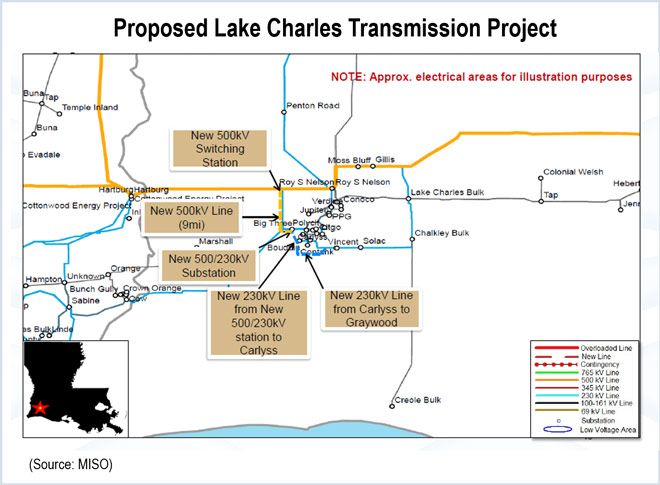By Chris O’Malley

“I know there are some contentious issues around this,” Jeff Webb, MISO’s director of planning, acknowledged shortly after opening a discussion of the project at a meeting of the South Technical Study Task Force in Metairie, La.
On Dec. 15, Entergy Gulf States Louisiana filed an out-of-cycle request with MISO, saying the need for the transmission upgrade was identified on Dec. 1. Entergy told MISO that increased industrial demand for power requires it complete the Lake Charles project by June 2018.
The company requested that the project be treated as an out-of-cycle project outside of the usual MISO Transmission Expansion Planning (MTEP) process and the competitive solicitation rules under the Federal Energy Regulatory Commission’s Order 1000.
At MISO’s Planning Advisory Committee meeting Jan. 28, transmission developers questioned the timing and motives behind Entergy’s request, which would deny them a chance to compete for the project. (See Entergy Out-of-Cycle Transmission Request Draws Competitors’ Ire.)
Webb started last week’s meeting by spending more than 30 minutes explaining MISO’s transmission planning rules, which limit out-of-cycle requests to reliability projects identified after the submittal cutoff date of the prior annual MTEP cycle with a need date within three years of the request date and expected in-service date within four years.
“We see the [Lake Charles] projects as fitting [the out-of-cycle] requirements,” Webb said.
Stakeholders Dubious
But, as during last month’s PAC meeting, stakeholders questioned how Entergy could only recently decide it needed the project and whether it needed to be done on a fast-track outside the MTEP.
A representative of NRG Energy asked Webb whether MISO had done any due diligence or simply took Entergy’s word “at face value.”
MISO officials replied that they are aware of substantial growth in the Gulf Coast region and that Entergy’s Module E load forecast data was consistent with the amount of load growth that’s been represented in the Lake Charles project. It would include two new substations, expansion of another and 25 miles of 500-kV and 230-kV transmission.
Edin Habibovic, manager of expansion planning at MISO, said that between MTEP 14 and MTEP 15, an additional 617 MW of growth was identified. Without upgrades, the increased loads could result in North American Electric Reliability Corp. violations due to overloaded transmission lines and voltage issues, Habibovic said.
George Dawe, vice president of Duke American Transmission, said evidence provided by Entergy amounts to anecdotal information.
“In our view, what’s the urgent need? I don’t see it anywhere. … It’s not a baseline reliability project,” Dawe said.
MISO officials said they have talked with Entergy’s industrial load customers, but that the customers haven’t been transparent about the timing of their power needs. Habibovic said obtaining detailed demand information from individual industrial companies is challenging in part, because they often make decisions at the last minute.
That wasn’t good enough for Dawe.
“A normal planning process has been thrown out the window,” he said. “It’s not a defined new load addition. It speculates on future economic development.”
Webb replied that if MISO ran the proposed project through the developer selection process, it would not meet Entergy’s deadline.
“We can’t risk going through that process and speculate that Entergy is wrong here — that the process could be done in two years versus two and a half years.”
MISO will not let the planning process stand in the way of needed transmission, he added, saying that’s why FERC allows exceptions to the competitive process under Order 1000.
No Attractive Alternatives
Habibovic said MISO has looked at alternatives to Entergy’s proposal to meet the increased demand, including routing power from Beaumont, 35 miles to the west in Texas, and from Lafayette, 50 miles to the east. Also modeled was an update of existing 230-kV lines.
He said the alternatives presented a number of problems, including reliability issues during construction, right-of-way challenges and high-impedance issues.
Kip Fox, director of transmission strategy and grid development at American Electric Power, asked if MISO reviewed recent public filings of electric customers who have deferred plant expansions. Other stakeholders cited reports that the drop in petroleum prices has put some liquefied natural gas projects in the Gulf region in limbo.
An Entergy representative replied that the timing of plant expansions can be volatile. Even if industrials delay a project, the need often resurfaces within a few years’ time, he said.
Cost-Overrun Concerns
Stakeholders also asked whether MISO had conducted due diligence on Entergy’s estimated costs for the project, questioning whether the $187 million price tag may grow.
Webb responded that most state regulatory agencies have provisions to deal with cost escalation and require utilities to justify overruns.
Board Consideration
Entergy’s out-of-cycle request will be discussed again at MISO’s Feb. 18 PAC meeting. It would then proceed to the System Planning Committee of the Board of Directors, likely in March, with potential consideration by the full board in April.
Overshadowed at the Metairie task force meeting by the Lake Charles discussion was a recommendation to approve five other out-of-cycle projects in the region, the largest at $10.3 million.

